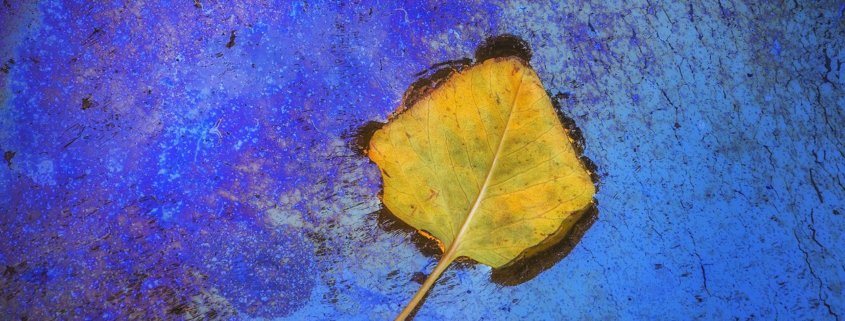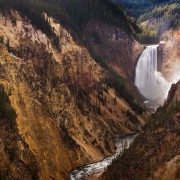Why Landscape Photographers Should Pursue Intimate Scenes
For many landscape photographers, we start out shooting a lot of wide angle grand scenics. While they are always incredible to witness and photograph, often times we are missing other incredible photographic opportunities. I have found myself shifting away from wide angle scenes and looking for more intimate scenes in nature. You don’t always have to fit everything you see into your viewfinder. Often times it is those smaller scenes that tend to just jump out at you and scream “take my photo”!

A lone leaf sits atop a layer of iridescent oils found in the narrows of Zion National Park in Utah.
One of my favorite things about these scenes is sometimes you find subjects that other viewers will question. It makes for a fun guessing game and really learning more about particular colors, textures, patterns, movement, scale and light. When you can combine all these factors into a single photograph, it can make for some truly compelling imagery. Often times, such scenes can be found right at your feet. It is quite amazing what you can find on the ground we walk on when we look.
Usually, the first thing I tend to look for with these small scenes are patterns and textures. One of the more popular subjects as of late are mud cracks. You can find a vast playa of intricate mud patterns, but trying to find just the right organization for a cohesive composition can be difficult. It is always best to spend some time surveying the area putting hypothetical puzzle pieces together. It is also a good practice to watch your every step as like sand dunes, you don’t want to ruin a potential composition. Once you find that perfect arrangement of patterns, then consider the lighting.
What lighting would make the scene jump out and be more interesting? Reflected light off a canyon wall? Sunset light? Twilight? It is not uncommon to photograph the same scene under various lighting conditions and spending considerable amount of time studying the scene. Perhaps the light is better in the morning, or better in the evening. Landscape photographers should take these things into account to make the most of these smaller images. The fun thing about mud is that there are numerous patterns they can create from mud tiles to curls.
When the seasons change, so do the possibilities of photographing those smaller scenes. During autumn, look for patterns in autumn foliage both within the trees and below your feet. Maybe you have a water feature which contained a pool of leaves. Are the leaves completely covering the water? Does the water show along the edges of the fallen leaves? These aspects can add impact to these scenes especially if you position your camera appropriately. Landscape photographers should be ready to experiment with filters like a polarizer to reduce glare and even a 10-stop ND filter to capture movement.

Autumn leaves piled in a pool of water as golden light from a canyon wall reflects onto the waters surface.
Once again, lighting here is key. Early morning and late evening light can yield incredible colors over these leaf patterns. Reflected light from canyon walls or nearby glowing trees can also add great color and impact to your intimate leaf scenes. By utilizing a 10-stop ND filter, you can capture the movement of foliage in a pool of water which may contrast with still leaves on the edge of the pool. Another way to incorporate movement into these types of scenes is to use in camera motion techniques. Try manually moving the camera up and down at slower shutter speeds to achieve a more painterly feel to your image.
Movement does not have to include fallen leaves or foliage in general. Flowing water is a perfect subject that really can incorporate all of the aspects needed for a compelling intimate scene. Creeks, streams, rivers and even lakes can make for some unique and interesting scenes with the right light and shutter speed. Water is one of those features that may feel quite repetitive photographically. Unlike mud and fallen leaves, water is usually moving and may take numerous exposures to find the perfect combination of light and and pattern. The movement of the water can be natural, such as cascades over rocks, or it can be manmade by a boat or walking through it.
With rushing water, texture is important, so choose a shutter speed that is slow enough to get the movement of the water, but fast enough to get the textures. In this case, smooth milky water tends to detract from the scene rather than help. If you are photographing ripples in the water, pay attention to color contrasts and patterns. Like rushing water, you will likely be shooting continuously until you find the patterns that appeal to you. This is one of the times as landscape photographers where you want to use a faster shutter speed to capture just the right movement in the water.
Not all small scenes are found at the tip of our toes. Consider looking at other subjects for small scene inspiration like tree branches, boulders, canyon walls, etc. Perhaps you come across a colorful lichen covered boulder along the trail or a large tree full of texture. You may even find wonderful intimate scenes looking up. No matter where you go, what your photographic goals are, there is sure to be options for smaller scenes to photograph. These scenes can be created on sunny clear blue days and even under dramatic light.

Details and patterns of an ancient bristlecone pine tree base. The base of this particular tree was nearly nine feet wide.
On your next photographic outing, challenge yourself to create some of these types of images. Flex those lenses focal lengths and get creative. Nature is all around us beckoning to be seen and photographed.







 Grant Collier
Grant Collier

